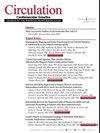QT Interval Determinant: Mutations, Rare Variants, or Single-Nucleotide Polymorphisms?
引用次数: 0
Abstract
Long-QT syndrome (LQTS) is typically characterized by QT interval prolongation on ECG associated with syncope or sudden cardiac death in young individuals when prolongation of the QT interval induces torsade de pointes, a polymorphic ventricular tachycardia that can degenerate into ventricular fibrillation.1 LQTS is characterized by mutations in several ion channel genes. Although >10 susceptible genes have been identified, KCNQ1 (LQT1), KCNH2 (LQT2), and SCN5A (LQT3) are the most common LQTS genes, accounting for ≈90% of all genotype-positive cases. Only <5% of cases are diagnosed as LQT4~15, and 20% to 30% of cases remain genetically elusive. In the past 2 decade, lots of LQTS clinical databases have revealed genotype–phenotype correlations in the 3 major LQTS (LQT1~3) subtypes and have indicated that the genotype, together with QTc interval, age, and sex, is a determinant of arrhythmic risk and response to medication therapy.2 Furthermore, not only genotype but also mutation site–specific differences in arrhythmic risk could be reported in LQT1 and LQT2.3,4 See Article by Rosenberg et al However, as in most Mendelian disorders, patient management is complicated by the variability in disease severity among LQTS mutation carriers.5 Even in the same mutation, for example, KCNQ1 -A341V, mutation carriers had a wide range of QTc values (406–676 ms), and 12% of individuals had a normal QTc (≤440 ms).6 Furthermore, in addition to the LQTS-causing gene mutations, other genetic polymorphisms, such as NOS1AP , KCNE1 -D85N may affect the QT …QT间期决定因素:突变,罕见变异,还是单核苷酸多态性?
本文章由计算机程序翻译,如有差异,请以英文原文为准。
求助全文
约1分钟内获得全文
求助全文
来源期刊

Circulation: Cardiovascular Genetics
CARDIAC & CARDIOVASCULAR SYSTEMS-GENETICS & HEREDITY
自引率
0.00%
发文量
0
审稿时长
6-12 weeks
期刊介绍:
Circulation: Genomic and Precision Medicine considers all types of original research articles, including studies conducted in human subjects, laboratory animals, in vitro, and in silico. Articles may include investigations of: clinical genetics as applied to the diagnosis and management of monogenic or oligogenic cardiovascular disorders; the molecular basis of complex cardiovascular disorders, including genome-wide association studies, exome and genome sequencing-based association studies, coding variant association studies, genetic linkage studies, epigenomics, transcriptomics, proteomics, metabolomics, and metagenomics; integration of electronic health record data or patient-generated data with any of the aforementioned approaches, including phenome-wide association studies, or with environmental or lifestyle factors; pharmacogenomics; regulation of gene expression; gene therapy and therapeutic genomic editing; systems biology approaches to the diagnosis and management of cardiovascular disorders; novel methods to perform any of the aforementioned studies; and novel applications of precision medicine. Above all, we seek studies with relevance to human cardiovascular biology and disease.
 求助内容:
求助内容: 应助结果提醒方式:
应助结果提醒方式:


